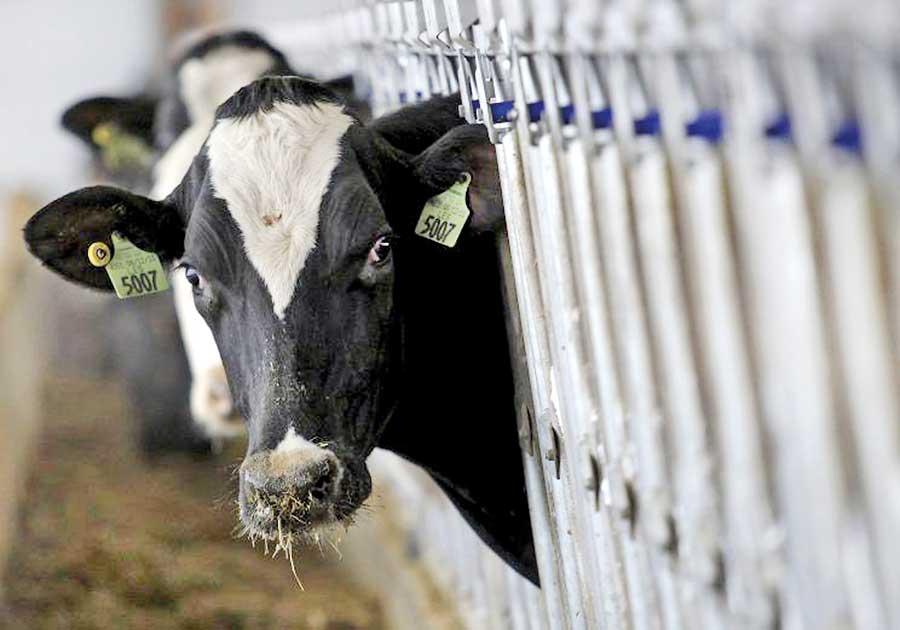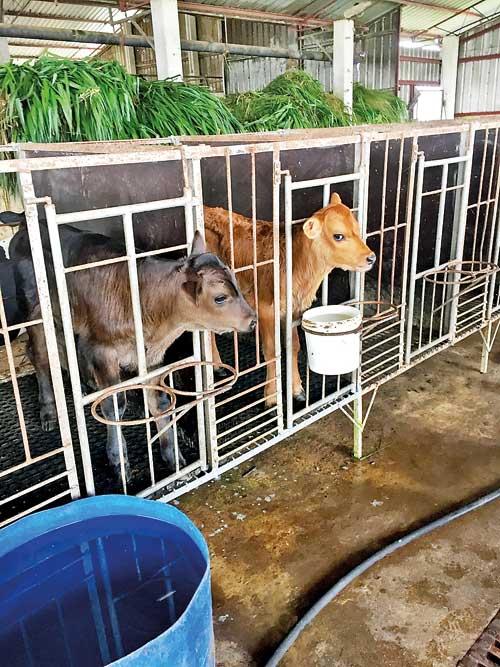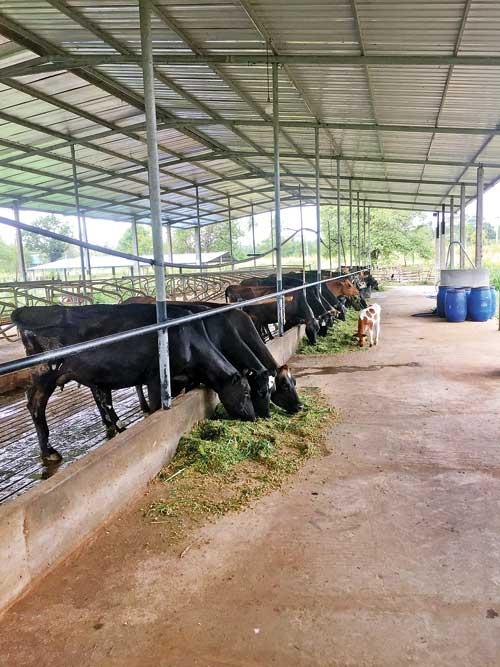Reply To:
Name - Reply Comment

State efforts are underway to import 2500 milch cows from Australia, despite a similar scheme carried out by the previous ‘Yahapalana’ government which saw many lapses. Recently, the Cabinet approved a proposal to import another 2500 milch cows while there were many controversies behind past projects, according to experts’ views.

In December 2019, many dairy farmers who purchased imported dairy heifers raised their voices on the dire crisis which they had to face with the looming threat of losing their property, in a battle to survive. Those who joined the dairy business recently had trusted the previous government and purchased dairy heifers following an import deal with Australia’s largest cattle exporter, Wellard Ltd.
“They were supposed to give us pregnant animals but I was given animals that hadn’t conceived too. As soon as we bought the animals, the animals ended up dying,” small scale dairy farmer alleged during the Daily Mirror’s visit to their isolated farms in December 2019.
The project runs back to 2012, where then Minister Basil Rajapaksa had commenced the import of heifers under an agreement with Australia’s Wellard Ltd. Under the 2012 programme, the government imported 2000 milch cows and through artificial insemination, these cows gave birth to nearly 1500 calves which were initially distributed among dairy farmers in the Dry Zone.
Due to the success of the first batch, on October 16, 2014, the Australian company and the Sri Lankan government signed an agreement to import another 20,000 milch cows to boost small and medium scale dairy farmers with an ambitious goal of making Sri Lanka self-sufficient in dairy farming by 2016.
After the‘Yahapalana’ government came into power in 2015, the government started continuing the project by importing another 5000 batch of dairy heifers in May 2015, and several failures had been observed during the importing process.
 The proprietor of Lammermoore Estate in Maskeliya, Amal Suriyage explained to the Daily Mirror that according to the agreement if the ‘Yahapalana’ government needed, they could have stopped importing the remaining 15,000 cows.
The proprietor of Lammermoore Estate in Maskeliya, Amal Suriyage explained to the Daily Mirror that according to the agreement if the ‘Yahapalana’ government needed, they could have stopped importing the remaining 15,000 cows.
“I bought 200 milch cows from the second stage of the project in May 2015. However, all of them died after they had been imported. All the animals were in poor condition during their arrival in December 2018. Only after they had been imported, we understood that these heifers were infected with Bovine Viral Diarrhoea (BVD), which is a serious disease. I had a mass burial ground at that time, not a farm,” he lamented.
At the Presidential Commission, which was appointed to probe into the corruption occurred within the period between 2015 and 2018, the dairy farmers’ grievances were taken up for debate, where some startling revelations surfaced pertaining to the importation of 20,000 milch cows.
During the testimony it was revealed that Foresight Engineering (Pvt.) Ltd served as the local agent for Wellard Rural Exports (Pvt.) Ltd, Australia. Several farmers informed the Commission that the officials attached to the Ministry of Rural Economic Development told them that these pregnant cows would produce 20 litres of milk per day on average, and went on to advise some investors to even get rid of the local cows from their farms.
In the vicinity of these revelations, it was also revealed to the Commission that each cow was valued at nearly Rs. 550,000 and that the ministry gave the cows at a subsidised rate of Rs. 200,000 to the farmers. The total cost of the project was more than Rs.13,500,000,000.
By March 2018, the ‘Yahapalana’ government imported 5000 milch cows and the project had already faced with several difficulties. At a time when the project needed numerous course corrections, in April 2018, former Secretary of the Rural Economic Development Ministry Renuka Ekanayake recommended a payment of another US$11 million to Wellard Exports, subsequently obtaining former line Minister P. Harrison’s approval.
Testifying before the Commission, former Chief Accountant attached to the Rural Economic Development Ministry Anton Perera informed the Commission that although the External Resources Department of the Treasury had paid Rs.1.3 billion (US$ 8.3 million) to Wellard Exports on May 8, 2018, there was no budgetary allocation for the project in the 2018 budget. During the proceedings it was also revealed that the Ministry of Rural Economic Development did not acquire the original copy of the agreement which the ministry signed with Wellard in 2014. Ministry’s then Additional Secretary Dharmasiri Ariyapala informed the Commission that he was unable to furnish an original copy of the agreement.
“The agreement was signed in 2014. The ministry only had a copy of that agreement and I brought a certified copy of that document,” Ariyapala informed the Commission. He also said that Project Coordinator, Sagarika Sumanasekera had informed him that the Ministry of Economic Development did not furnish them with the original copy, despite a request was made.
The Ministry of Economic Development’s own internal audit department had conducted an internal audit with regard to the matter and according to the report
- By May 2016, govt. had spent Rs. 88,058,958 on the project and that amount was already a burden to the government due to several reasons.
- The government had failed to get insurance for imported cows and by May 30, 2016, almost 133 cows died, incurring a loss of Rs. 55,244,535 to the government.
- According to the agreement signed on July 24, 2014, Wellard Rural Exports Pvt. Ltd agreed to provide as much as Jersey cattle breed required during the importation. By October 2015 the government had imported 2,495 cows and only 1,053 belonged to Jersey cattle breed
- If these animals were retained at Ridiyagama farm for a longer period, the government must implement an alternative solution such as solar power panels to get electricity to create artificial environment. But the government had failed to establish such processes within this project

The ministry’s own internal audit department had conducted an internal audit with regard to the matter and according to the report, by May 2016 the government had spent Rs. 88,058,958 on the project and that amount was already a burden to the government due to several reasons. According to the report, the government had failed to get insurance cover for the imported cows, and by May 30, 2016, almost 133 cows had been dead and incurred a loss of Rs. 55,244,535 to the government.
The report also mentioned that according to the agreement signed on July 24, 2014,Wellard Rural Exports (Pvt.) Ltd agreed to provide Jersey cattle breed. By October 2015 the government had imported 2,495 cows and only 1,053 among them were Jersey cows. The Ministry also had to appoint a special committee to check the loan repayment, but it was not appointed till March 2018.
It was also revealed that if these animals were retained at Ridiyagama farm for a long period, the government must have implemented an alternative solution, such as solar power panels to get electricity to create an artificial environment. But the government had failed to establish such processes within this project.
Due to above reason, in 2015 the government had spent Rs.5, 729, 028 to generate electricity to keep the animals in an artificial environment and by 2016 the expenses doubled to Rs. 39,993,949.
By conducting the project, the former government had also imported a silent killing disease along with these animals. Although the Ministry of Rural Economic Development issued continual warning on the deadly disease, which was carried by the Milch cows, the Ministry had failed to take proper action on the matter.
“There was no effective treatment or vaccine for BVD. The disease, not only causes death, but also spreads rapidly infecting healthy cattle as well. The disease was never reported in the country prior to the arrival of these cattle from Australia,” former Veterinary Surgeon Rohan Perera told the Daily Mirror.
Against this backdrop, the incumbent government has taken a decision to import 2500 cattle under the Agriculture Ministry’s ‘Saubhagya Project.’
Highlighting the new developments to the project, National Livestock Development Board (NLDB) Chairman, Prof. Manjula Magammana said that the Ministry had decided to terminate the existing agreement on importing of cattle. “The Ministry had decided to terminate the existing agreement and there will be a scope change of the whole project,” he said.
Prof. Magammana said that according to the current plan, the 2500 cattle planned to be imported were not be distributed among dairy and livestock farmers but rather to farms under the NLDB for breeding purposes. He said Sri Lanka never imported any animal previously until 2012, but after implementing decisions to increase agricultural production, the country had started importing animals.
Increasing agricultural production and improving the quality of milk and meat are key areas to increase food security in the country. “The country is currently trying to take some innovative steps considering nuclear and nuclear-derived techniques to control and prevent diseases among livestock and boost cattle and milk production,” he said.
While addressing the issues pertaining to the previous cattle imports by the ‘Yahapalana’ government, he said there was a serious issue in the quarantine process conducted for these animals. “Whoever made the decision to issue the imported animals directly to farmers was totally against the principles. There should be a proper quarantine process for these animals before handing them over to farmers. Having a quarantine process in place only we can recognise the behavior and the diseases of these animals,” he said.
He said that the country could have controlled BVD, if the animal health authorities had conducted a proper quarantine for these animals. “Normally, when we maintain a dairy farm, if there is a breakdown in the first three years, no profit could be achieved during that period. From the fourth year onwards, dairy farmers could yield profits from their business,” he said. Prof. Magammana said according to the present project, the Ministry had decided to train farmers who wish to start a dairy farm upon the promise that the Ministry would implement a National Dairy Development Centre for learning purposes.
“Most farmers who purchased cattle from the previous project, were new to the business and they did not receive training. 60% of their income had been used to feed these animals and it was not a healthy situation for a dairy farming industry. We have to follow certain protocols when managing a dairy farm,” Prof. Magammana said.